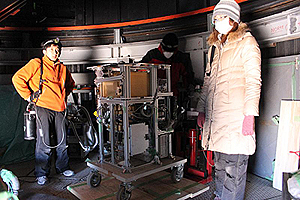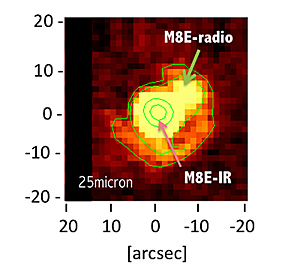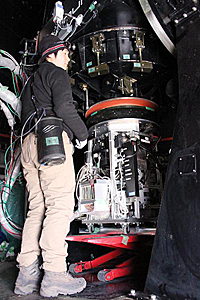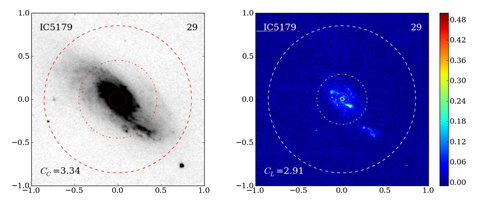
|
TAO Project |
|
The TAO project

|
University of Tokyo Master Thesis Presentation 2011
|
|
In this thesis, M8E, a massive star forming region, was observed with MAX38, which have been developed and operated by Miyata Laboratory, a mid-infrared research group to which the author belongs. Massive stars in early formation stage are not observable in the visible and near-infrared wavelengths because they are born in thick dusty cores. Mid-infrared observations are very useful to investigate such dusty regions because mid-infrared light can penetrate the dusty regions more deeply than visible and near-infrared light and resolve more finely than far-infrared and radio waves. MAX38 on the miniTAO 1-m telescope in the Atacama Desert, Chile, was used for the observations. The author actually went there and conducted the observations. M8E, the target, is a massive star forming region at a distance of 1.5 kpc from the sun. It consists of two objects, M8E-IR and M8E-radio. M8E-IR is a young stellar object enough bright to be observable in the near-infrared wavelengths. M8E-radio is a radio source (but very dark in the near-infrared wavelengths) which is thought to have evolved more than M8E-IR. There had been no imaging observations of M8E-radio in the visible and infrared bands, except that it had been imaged separately from M8E-IR at a wavelength of 24.5 um by COMICS on the Subaru telescope. In this work, M8E region was imaged at 30 and 37 um, and the two objects were spatially decomposed for the first time by our observations. The total luminosity and mass of each object were successfully estimated from the data. It was found that M8E-radio is less-massive star than M8E-IR. If stars with various mass are born at once in one molecular cloud, higher-mass stars evolve faster. Then, assuming the two objects in M8E region were born at once in the same molecular cloud, as usually thought, the relation of their mass and evolutional stages contradict our estimation. Finally, it was estimated that M8E-radio had been born at 30,0000 years before M8E-IR was born. Such born-time difference of stars has been found in the massive star clusters, with a spatial scale more than ten times larger than the massive star forming region like M8E. However, in the massive star forming region with smaller spatial scale, it has not been confirmed because of the lack of detailed observations. The discovery of the born-time difference is very interesting to investigate massive star formation in molecular clouds. |
2. "Ground-based Paschen-alpha Imaging Method and Paschen-alpha Survey of Local LIRGs"
This is the master thesis of Mr. Ken Tateuchi. Thirty-eight infrared galaxies were surveyed with ANIR, the near-infrared camera on the miniTAO telescope, in the five observing campaigns. The result of the survey is reported in this thesis.
|
Many large-scale deep surveys have revealed that the star formation activity in the universe is more strenuous in past days and that Ultra-Luminous and Luminous Infrared Galaxies (U/LIRGs) play a main role in the past star formation activities. However, the properties of U/LIRGs and their star formation activity are still unknown. This is because the detailed observations toward distant galaxies (red shift z>1) are difficult for current technology. This work aims to understand galaxy evolution by revealing the detailed star formation activity in nearby LIRGs (z<0.1) enough close to probe inner structures. Paschen-alpha (1.875 um) line, a strong hydrogen-recombination line, is appropriate to probe the star formation activity of U/LIRGs. It is because the line is a direct indicator of star formation and robust over dust extinction. However, the line is difficult to observe from ground-based observatories because of the severe atmospheric extinction in that wavelength region. Atacama Near InfraRed camera: ANIR is a near-infrared camera on the miniTAO 1-m telescope at the summit of Co. Chajnantor in Chile (5640-m altitude). The Paschen-alpha line can be stably observed at the site because near-infrared atmospheric window is extended by the low PWV (precipitable water vapor) environment (about 0.5 mm) given by the high altitude and dry climate. In addition, as frequent clear nights (80-90%) and good seeing (median: <0.8arcsec) are available, the site is very suitable for infrared observations. In this thesis, the local LIRGs (2800 km/s< cz< 8100 km/s), whose Paschen-alpha lines are observable with the N191 filter (1.9 um) in ANIR, were surveyed by ANIR. Finally, thirty-eight LIRGs (and quasi-LIRGs) were imaged in Paschen-alpha. The star formation activity veiled by dust was directly resolved by the obtained images, and the relation between the star formation rate and the morphology of galaxies, evaluated by concentration index, was derived. In the relation, two separated modes were confirmed clearly. One is "compact mode", the distribution of stars and star forming regions is alike with elliptical galaxies, and the other is "normal mode", the distribution of stars is alike with spiral or irregular galaxies. The origin of the two different modes will be investigated in future works. |



